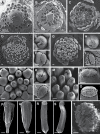Homology and functions of inner staminodes in Anaxagorea javanica (Annonaceae)
- PMID: 33343856
- PMCID: PMC7733590
- DOI: 10.1093/aobpla/plaa057
Homology and functions of inner staminodes in Anaxagorea javanica (Annonaceae)
Abstract
Inner staminodes are widespread in Magnoliales and present in Anaxagorea and Xylopia, but were lost in the other genera of Annonaceae and have no counterparts in derived angiosperms. The coexistence of normal stamens, modified stamens and inner staminodes in Anaxagorea javanica is essential to understand the homology and pollination function of the inner staminodes. Anaxagorea javanica was subjected to an anatomical study by light and scanning electron microscopy, and the chemistry of secretions was evaluated by an amino acid analyser. Inner staminodes have a secretory apex, but do not have thecae. They bend towards either tepals or carpels at different floral stages, and function as a physical barrier preventing autogamy and promoting outcrossing. At the pistillate phase, the exudates from the inner staminodes have high concentration of amino acid, and provide attraction to pollinating insects; while abundant proline was only detected in stigmas exudates, and supply for pollen germination. Modified stamens have a secretory apex and one or two thecae, which are as long as or shorter than that of the normal stamens. As transitional structures, modified stamens imply a possible degeneration progress from normal stamens to inner staminodes: generating a secretory apex first, shortening of the thecae length next and then followed by the loss of thecae. The presence of modified stamens together with the floral vasculature and ontogeny imply that the inner staminodes are homologous with stamens.
Keywords: Anaxagorea javanica; Annonaceae; homology; inner staminode; modified stamen; pollination function.
© The Author(s) 2020. Published by Oxford University Press on behalf of the Annals of Botany Company.
Figures










Similar articles
-
Floral development and floral phyllotaxis in Anaxagorea (Annonaceae).Ann Bot. 2011 Oct;108(5):835-45. doi: 10.1093/aob/mcr201. Epub 2011 Aug 5. Ann Bot. 2011. PMID: 21821626 Free PMC article.
-
Floral ontogeny of Annonaceae: evidence for high variability in floral form.Ann Bot. 2010 Oct;106(4):591-605. doi: 10.1093/aob/mcq158. Epub 2010 Sep 1. Ann Bot. 2010. PMID: 20810741 Free PMC article.
-
Comparative structure and pollen production of the stamens and pollinator-deceptive staminodes of Commelina coelestis and C. dianthifolia (Commelinaceae).Ann Bot. 2005 Jun;95(7):1113-30. doi: 10.1093/aob/mci134. Epub 2005 Mar 29. Ann Bot. 2005. PMID: 15797898 Free PMC article.
-
The evolution of floral biology in basal angiosperms.Philos Trans R Soc Lond B Biol Sci. 2010 Feb 12;365(1539):411-21. doi: 10.1098/rstb.2009.0228. Philos Trans R Soc Lond B Biol Sci. 2010. PMID: 20047868 Free PMC article. Review.
-
Obdiplostemony: the occurrence of a transitional stage linking robust flower configurations.Ann Bot. 2016 Apr;117(5):709-24. doi: 10.1093/aob/mcw017. Epub 2016 Mar 24. Ann Bot. 2016. PMID: 27013175 Free PMC article. Review.
References
-
- Armstrong JE, Irvine AK. 1990. Functions of staminodia in the beetle-pollinated flowers of Eupomatia laurina. Biotropica 22:429–431.
-
- Baker HG. 1977. Non-sugar chemical constituents of nectar. Apidologie 8:349–356.
-
- Baker HG, Baker I. 1975. Studies of nectar-constitution and pollinator-plant coevolution. Coevolution of Animals and Plants 100:591–600.
-
- Braun M, Gottsberger G. 2011. Floral biology and breeding system of Anaxagorea dolichocarpa (Annonaceae), with observations on the interval between anthesis and fruit formation. Phyton-Annales Rei Botanicae 51:315–327.
-
- Chatrou LW, Pirie MD, Erkens RHJ, Couvreur TLP, Neubig KM, Abbot JR, Mols JB, Maas JW, Saunders RMK, Chase MW. 2012. A new subfamilial and tribal classification of the pantropical flowering plant family Annonaceae informed by molecular phylogenetics. Botanical Journal of the Linnean Society 169:5–40.
LinkOut - more resources
Full Text Sources
Research Materials
Miscellaneous

